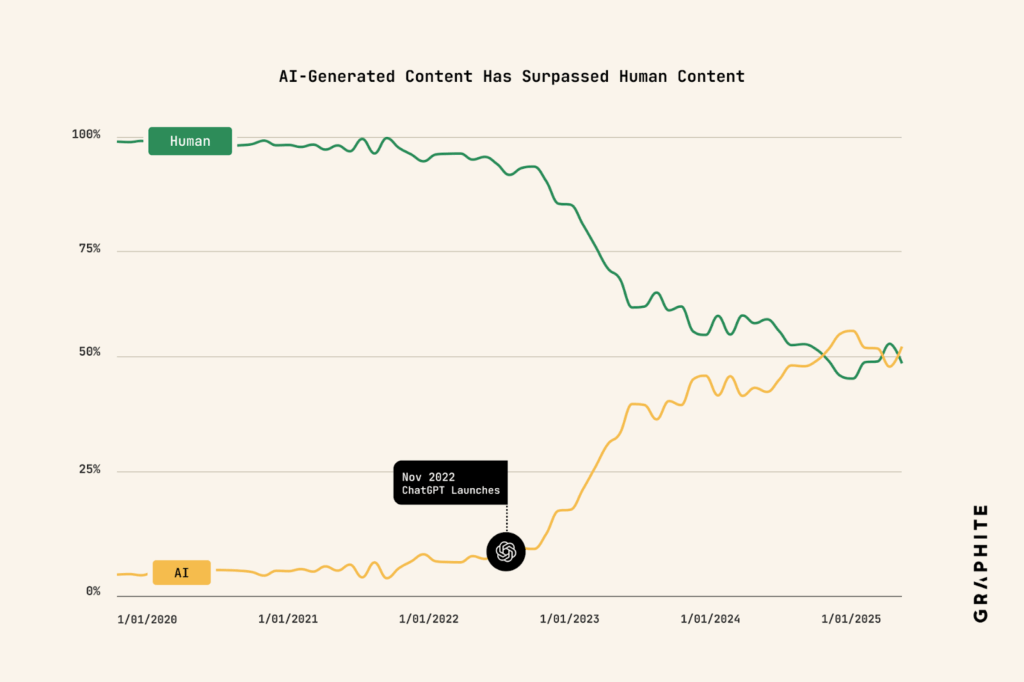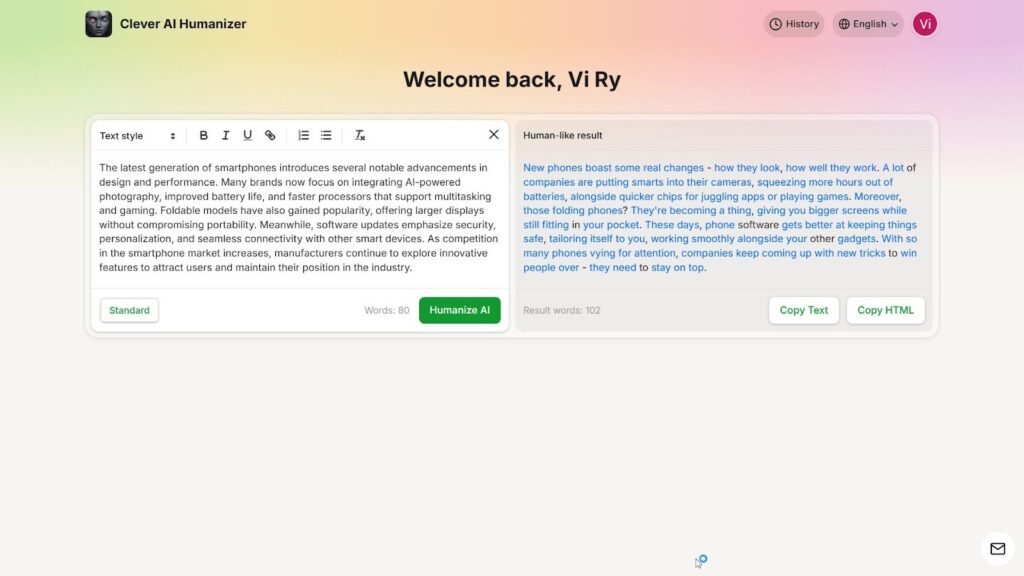Blogs, articles, research papers, or even a script to a YouTube video from your favorite content creator, AI writing is everywhere. Machine-generated text now fills a large portion of what we consume online. It’s quick and convenient; however, that speed comes at a cost. Automated drafts often sound too mechanical, too perfect, polished, or simply out of touch with real human expression. It can contain mistakes or simply alienate readers. That’s why the next stage of content evolution is all about merging human creativity with machine capabilities.
Why Humanizing AI Writing Matters
So, how much content is actually AI-generated? It’s really hard to tell, since almost everyone uses AI writing assistants, but we have some interesting statistics. A study by Graphite, which examined articles from 2020-2025, found that in November 2024, the quantity of AI-generated articles being published on the web surpassed the number of human-written ones. Also, according to an education-focused analysis by Copyleaks, there was a 76% increase in AI-generated material among student assignments between January 2023 and January 2024.

It’s the new reality we live in. AI tools have made writing faster than ever, but not necessarily better. Humans instinctively recognize when something feels “off.” They can identify AI-written content – overly balanced sentence patterns and generic transitions like “in conclusion” or “as a result.” Meanwhile, AI content detection tools pick up on the same cues mathematically, scanning for predictable token structures and low “burstiness” (lack of variation in language). Among other reasons:
- Search engines prefer authentic writing. Google’s algorithms now prioritize content with originality and human context over purely machine-generated text by AI content writing tools.
- Credibility depends on tone and nuance. Academic papers and professional reports lose authority when they read like automated summaries.
- Brands can lose audience loyalty. Consistent, human tone strengthens brand voice, something AI alone can’t maintain. Unnatural writing damages perception and engagement.
- Academic institutions enforce strict integrity policies. Students caught submitting unedited AI text risk grade reductions or disciplinary action.
- Ethical and transparency standards are rising. Institutions and companies increasingly expect writers to acknowledge and refine AI use responsibly. So, you should be careful with your resume writing.
Best Ways to Make AI Text More Human
Machine-written text often sounds balanced to a fault. It may look fine at first glance, but it feels empty when read closely. That’s why simply generating content isn’t enough anymore. To stand out, you need to refine that draft.
We’ll cover the best tested AI content writing techniques to make generated text sound natural and engaging. The writing tips below combine automation and manual refinement to help you turn AI text into writing that feels genuinely human.
Get exclusive access to all things tech-savvy, and be the first to receive
the latest updates directly in your inbox.
Here is how to humanize AI content:
Method 1: Humanize AI Writing with a Humanizer Tool
An Humanizer AI can quickly refine machine-generated drafts and break the rigid token patterns that AI writing detection software flags. It adjusts phrasing and introduces sentence variety while preserving meaning. We tested various websites that humanize AI writing, both free and paid.
Among them, some tools stand out. You can make AI writing sound natural with Clever AI Humanizer. It is a completely free tool that allows up to 120,000 words per month and 4,000 words per run. It can rewrite AI generated content into human-like text without errors or awkward transitions.
Here is how to use it to avoid AI detection in writing:
- Visit the Clever AI Humanizer website.
- Paste or upload your AI-generated text.
- Click “Humanize AI” and let the tool process the content.

- Review the rewritten version and copy or export it for use.
It’s a great way to humanize AI content without spending money. Unlike basic paraphrasers, Clever AI Humanizer focuses on structure and readability. It also has a history, so you can go back to previously humanized drafts if needed. It’s ideal for long-form articles, app descriptions, or academic writing where fluency and precision both matter.
Method 2: Edit for Rhythm and Variation
AI-generated text often gives itself away through repetitive structure and predictable phrasing. Even when the grammar is perfect, it lacks the rhythm, unpredictability, and emotional tone that make human writing engaging. That’s why editing for rhythm and variation is one of the most powerful ways to humanize AI-generated text. AI models, trained on vast datasets, tend to reuse the same “safe” sentence structures and transition words. You’ll often see recurring patterns:
- Common transitions like “In conclusion,” “As a result,” “In today’s world,” “It’s important to note,” “Overall,” “In this article,” “That being said.”
- Predictable connectors such as “Not only… but also,” “On the other hand,” “For instance,” “Therefore,” “Moreover,” “Furthermore.”
- Filler openers like “There are many reasons why…,” “One of the most important things is…,” “It can be said that…,” “When it comes to…”
- Redundant endings like “as a whole,” “at the end of the day,” “in summary,” “to sum up.”
Humans rarely write this way consistently. Real writing naturally fluctuates, short sentences follow long ones, tone shifts mid-paragraph, and transitions feel intuitive rather than formulaic. To fix this, break uniformity wherever you see it. Start a paragraph with a short punchy statement, then follow it with a more detailed explanation. Use natural pauses (commas, em-dashes, or colons) to vary pacing. Swap formal linkers like “moreover” with more natural ones like “also,” “plus,” or “even so.” This way, you will have a lesser chance that tools will detect AI writing.
Method 3: Make AI Writing More Human by Adding Context and Real-World Examples
AI-generated content can cover a topic accurately but still feel hollow because it lacks lived experience. Replace vague claims with case studies, brand examples, or data points.
For instance, instead of saying “AI tools improve marketing efficiency,” write “A digital agency using automation software cut campaign turnaround times by 30%.” This kind of tangible detail gives your writing credibility and makes it sound unmistakably human.
Method 4: Match the Brand or Author Voice
Even polished AI text can sound detached. To fix that, align tone and vocabulary with your brand or personal style. A tech company might prefer precise, concise language, while a lifestyle brand may favor conversational phrasing. If the writing feels too formal, simplify it. If it feels too casual, tighten the structure. The goal is to make the text sound consistent with how your audience expects you to communicate.

Method 5: Fact-Check Every Claim
AI tools sometimes invent statistics, quotes, facts or references that appear legitimate but don’t exist. This problem, known as hallucination, is common across all large language models. Before publishing, verify every number, citation, event and name. Check credible databases or original sources, especially in academic writing. Failure to do so can hurt credibility or even lead to penalties.

A recent case in Canada illustrates how damaging this issue can be. In October 2025, The Guardian reported that a Quebec resident was fined C$5,000 (US$3,562) after submitting fabricated legal citations generated by AI as part of his defense. The judge called his behavior “highly reprehensible,” warning that such misuse of artificial intelligence could undermine the integrity of the legal system.
Why the Future of AI Writing Is Human-Centered
After years of hype around automation, the online world is now flooded with machine-written articles and filler blogs that all sound the same. Even some authors are now writing a book with AI. Readers have started pushing back, coining terms like “AI slop” to describe the avalanche of low-quality, mass-produced content that clutters news feeds and search results. The result is a constant comparison of AI to human writing and a growing appetite for human-centered text, for content that feels personal and genuinely insightful.
This frustration isn’t limited to blogs or news sites. Even tech giants are under fire for over-automating information delivery. When Google rolled out its AI Overview feature in 2024, users flooded X (formerly Twitter) and Reddit with screenshots mocking bizarre or dangerous search results, including one that told people to eat rocks for calcium. What was meant to be a time-saving tool became a meme overnight.
Some major outlets have fueled this situation as they faced backlash for publishing AI-written articles without clear disclosure, some of which contained plagiarism or fabricated facts. Each case eroded public trust in mainstream media and amplified the demand for transparency.
Final Thoughts
As the percentage of generated content continues to rise and people use AI help with writing, human-centered writing will define quality, credibility, and engagement. The future doesn’t belong to AI or humans alone; it belongs to both, working together to create writing that’s fast and that’s impossible to ignore. Tools like AI humanizers make this partnership possible. While machines are great at structure and grammar, humans bring intuition and nuance.
FAQ
Can AI writing software be used safely in professional or academic contexts?
Yes, but responsibly. Many professionals and content creators use AI writing software as a starting point, just to draft outlines or generate ideas. However, the final text must reflect human judgment and fact-checking. In academic settings, institutions often require clear disclosure when AI is used. Submitting unedited AI text can violate integrity policies or trigger penalties if a detector flags your work as machine-written.
What is an AI writing detector, and how does it work?
An AI writing detector analyzes patterns in text, such as sentence length, structure, token probability, and word repetition. AI detectors determine if it was generated by a machine. Tools like Originality.ai and Turnitin’s AI detection system look for mathematical consistency and lack of linguistic variation, traits that AI writing software often produces. However, these systems aren’t perfect. Even human-written content can be misclassified, which is why refining AI drafts to include natural rhythm and context remains quite important.
How can I make my AI-generated text undetectable?
The most reliable way to make AI text sound human and bypass detection is to use a dedicated humanizer. It reworks sentence flow and tone, and keeps meaning intact, something paraphrasers or rewriters can’t really do. After humanizing, review your text manually to adjust structure, add examples, and refine transitions. These small changes break the rigid patterns that AI writing detectors use to identify machine-written content.


